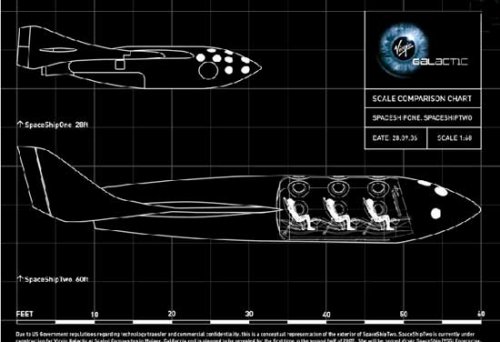Quite key for why reusable SSTO's will make manned space travel routine is the small size and low cost they can be produced. A manned SSTO can be produced using currently existing engines and stages the size of the smallest of the very light, or personal, jets [1], except it would use rocket engines instead of jet engines, and the entire volume aft of the cockpit would be filled with propellant, i.e., no passenger cabin. So it would have the appearance of a fighter jet.
We'll base it on the SpaceX Falcon 1 first stage. According to the Falcon 1 Users Guide on p.8 [2], the first stage has a dry mass of 3,000 lbs, 1,360 kg, and a usable propellant mass of 47,380 lbs, 21,540 kg. We need to swap out the low efficiency Merlin engine for a high efficiency engine. However, SpaceX has not released the mass for the Merlin engine. We'll estimate it from the information here, [3]. From the given T/W ratio and thrust, I'll take the mass as 650 kg.
We'll replace it with the RD-0242-HC, [4]. This is a proposed modification to kerosene fuel of an existing hypergolic engine. This type of modification where an engine has been modified to run on a different fuel has been done before so it should be doable [5], [6]. The engine mass is listed as 120 kg. We'll need two of them to loft the vehicle. So the engine mass is reduced from that of the Merlin engine mass by 410 kg, and the dry mass of the stage is reduced down to 950 kg. Note that the mass ratio now becomes 23.7 to 1.
We need to get the Isp for this case. For a SSTO you want to use altitude compensation. The vacuum Isp of the RD-0242-HC is listed as 312 s. However, this is for first stage use so it's not optimized for vacuum use. Since the RD-0242-HC is a high performance, i.e., high chamber pressure engine, with altitude compensation it should get similar vacuum Isp as other high performance Russian engines such as the RD-0124 [7] in the range of 360 s. As a point of comparison the Merlin Vacuum is a version of the Merlin 1C optimized for vacuum use with a longer nozzle. This increases its vacuum Isp from 304 s to 342 s [8]. I've also been informed by email that engine performance programs such as Propep [9] give the RD-0242-HC an ideal vacuum Isp of 370 s. So a practical vacuum Isp of 360 s should be reachable using altitude compensation.
For the sea level Isp of the RD-0242-HC, again the version of the high performance, high chamber pressure, RD-0124 with a shortened nozzle optimized for sea level operation gets a 331 s Isp. So I'll take the sea level Isp as this value using altitude compensation that allows optimized performance at all altitudes.
To calculate the delta-V achievable I'll follow the suggestion of Mitchell Burnside Clapp who spent many years designing and working on SSTO projects including stints with the DC-X and X-33 programs. He argues that you
should use the vacuum Isp and just use 30,000 feet per second, about 9,150 m/s, as the required delta-V to orbit for dense propellants [10]. The reason for this is that you can just regard the reduction in Isp at sea level and low altitude as a loss and add onto the required delta-V for orbit this particular loss just like you add on the loss for air drag and gravity loss. Then with a 360 s vacuum Isp we get a delta-V of 360*9.8ln(1 + 21,540/950) = 11,160 m/s. So we can add on payload mass: 360*9.8ln(1+21,540/(950 + 790)) = 9,150 m/s, allowing a payload of 790 kg.
To increase the payload we can use different propellant combinations and use lightweight composites. Dr. Bruce Dunn wrote a report showing the payload that could be delivered using high energy density hydrocarbon fuels other than kerosene [11]. For methylacetylene he gives an ideal vacuum Isp of 391.1 s. High performance engines can get get ca. 97% and above of the ideal Isp so I'll take the vacuum Isp value as 384 s. Dunn notes that Methyacetylene/LOX when densified by subcooling gets a density slightly above that of kerolox, so I'll keep the same propellant mass. Then the payload will be 1,120 kg: 384*9.8ln(1 + 21,540/(950 + 1,120)) = 9,160 m/s.
We can get better payload by reducing the stage weight by using lightweight composites. The stage weight aside from the engines is 710 kg. Using composites can reduce the weight of a stage by about 40%. Then adding back on the engine mass this brings the dry mass to 670 kg. So our payload can be 1,400 kg: 384*9.8ln(1 + 21,540/(670 + 1,400)) = 9,160 m/s.
Note this has a very high value for what is now regarded as a key figure of merit for the efficiency of a launch vehicle: the ratio of the payload to the dry mass. The ratio of the payload to the gross mass is now recognized as not being a good figure of merit for launch vehicles. The reason is that payload mass is being compared then to mostly what makes up only a minor proportion of the cost of a launch vehicle, the cost of propellant. By comparing instead to the dry mass you are comparing to the expensive components of the vehicle, the parts that have to be constructed and tested [12].
This vehicle in fact has the payload to dry mass ratio over 2. Every other launch vehicle I looked at, and possibly every other one that has ever existed, has the ratio going in the other direction, i.e., the dry mass is greater than the payload mass. Often it is much greater. For example for the space shuttle system the dry mass is over 12 times that of the payload mass, undoubtedly contributing to the high cost for the payload delivered.
Because of this high value for this key figure of merit, this vehicle would be useful even as a expendable launcher. However, a SSTO is most useful as a reusable vehicle. This will be envisioned as a vertical take-off vehicle. However, it could use either a winged horizontal landing or a powered vertical landing. This page gives the mass either for wings or propellant for landing as about 10% of the dry, landed mass [13]. It also gives the reentry thermal protection mass as 15% of the landed mass. The landing gear mass is given as 3% of the landed mass here [14]. This gives a total of 28% of the landed mass for reentry/landing systems. With lightweight modern materials quite likely this could be reduced to half that.
If you use the vehicle just for a cargo launcher with cargo left in orbit, then the reentry/landing system mass only has to cover the dry vehicle mass so with lightweight materials perhaps less than 100 kg out of the payload mass has to be taken up by the reentry/landing systems. For a manned launcher with the crew cabin being returned, the reentry/landing systems might amount to 300 kg, leaving 1,100 kg for crew cabin and crew. As a mass estimate for the crew cabin, the single man Mercury capsule only weighed 1,100 kg [15 ]. With modern materials this probably can be reduced to half that.
For the cost, the full two stage Falcon 1 launcher is about $10 million. The engines make up the lion share of the cost for launchers. So probably much less than $5 million just for the 1st stage sans engine. Composites will make this more expensive but probably not much more than twice as expensive. For the engine cost, Russian engines are less expensive than American ones. The RD-180 at 1,000,000 lbs vacuum thrust costs about $10 million [16], and the NK-43 at a 400,000 lbs vacuum thrust costs about $4 million [17]. This is in the range of $10 per pound of vacuum thrust. On that basis we might estimate the cost of the RD-0242-HC of about 30,000 lbs vacuum thrust as $300,000. We need two of them for $600,000.
So we can estimate the cost of the reusable version as significantly less than $10,600,000 without the reentry/landing system costs. These systems added on for reusability at a fraction of the dry mass of the vehicle will likely also add on a fraction on to this cost. Keep in mind also that the majority of the development cost for the two stage Falcon 1 went to development of the engines so in actuality the cost of just the first stage without the engine will be significantly less than half the full $10 million cost of the Falcon 1 launcher. The cost of a single man crew cabin is harder to estimate. It is possible it could cost more than the entire launcher. But it's likely to be less than a few 10's of millions of dollars.
REFERENCES.
1.)List of very light jets.
http://en.wikipedia.org/wiki/List_of_very_light_jets
2.)Falcon 1 Users Guide.
http://www.spacex.com/Falcon1UsersGuide.pdf
3.)Merlin (rocket engine)
4 Merlin 1C Engine specifications
http://en.wikipedia.org/wiki/Merlin_(rocket_engine)#Merlin_1C_Engine_specifications
4.)RD-0242-HC.
http://www.astronautix.com/engines/rd0242hc.htm
5.)LR-87.
http://en.wikipedia.org/wiki/LR-87
6.)Pratt and Whitney Rocketdyne's RS-18 Engine Tested With Liquid Methane.
by Staff Writers
Canoga Park CA (SPX) Sep 03, 2008
http://www.space-travel.com/reports/Pratt_and_Whitney_Rocketdyne_RS_18_Engine_Tested_With_Liquid_Methane_999.html
7.)RD-0124.
http://www.astronautix.com/engines/rd0124.htm
8.)Merlin (rocket engine).
2.5 Merlin Vacuum
http://en.wikipedia.org/wiki/Merlin_(rocket_engine)#Merlin_Vacuum
9.)Propep
http://www.spl.ch/software/index.html
10.)Newsgroups: sci.space.policy
From: Mitchell Burnside Clapp <cla...@plk.af.mil>
Date: 1995/07/19
Subject: Propellant desity, scale, and lightweight structure.
http://groups.google.com/group/sci.space.policy/browse_frm/thread/3d981607d59684dc/945baea33c95a22?hl=en
11.)Alternate Propellants for SSTO Launchers
Dr. Bruce Dunn
Adapted from a Presentation at:
Space Access 96
Phoenix Arizona
April 25 - 27, 1996
http://www.dunnspace.com/alternate_ssto_propellants.htm
12.)A Comparative Analysis of Single-Stage-To-Orbit Rocket and Air-Breathing Vehicles.
p. 5, 52, and 67.
http://govwin.com/knowledge/comparative-analysis-singlestagetoorbit-rocket-and/15354
13.)Reusable Launch System.
http://en.wikipedia.org/wiki/Reusable_launch_system#Horizontal_landing
14.)Landing gear weight (Gary Hudson; George Herbert; Henry Spencer).
http://yarchive.net/space/launchers/landing_gear_weight.html
15.)Mercury Capsule.
http://www.astronautix.com/craft/merpsule.htm
16.)Wired 9.12: From Russia, With 1 Million Pounds of Thrust.
http://www.wired.com/wired/archive/9.12/rd-180.html
17.)A Study of Air Launch Methods for RLVs.
Marti Sarigul-Klijn, Ph.D. and Nesrin Sarigul-Klijn, Ph.D.
AIAA 2001-4619
p.13
http://mae.ucdavis.edu/faculty/sarigul/aiaa2001-4619.pdf


